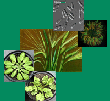| Uraguchi, S; Weber, M; Clemens, S: Elevated root nicotianamine concentrations are critical for Zn hyperaccumulation across diverse edaphic environments, Plant Cell and Environment, 42, 2003-2014 (2019), doi:10.1111/pce.13541 [Link] | |
| Abstract: The metallophyte Arabidopsis halleri thrives across an extremely broad edaphic range. Zn hyperaccumulation is found on soils differing in available Zn by up to six orders of magnitude, raising the question as to whether a common set of mechanisms confers this species-wide ability. Elevated root concentrations of the metal chelator nicotianamine due to strong constitutive expression of AhNAS2 are important for hyperaccumulation. In order to analyse the relevance of AhNAS2 under more natural conditions representing a range of metalliferous and nonmetalliferous habitats, we collected soil at eight different A. halleri sites and cultivated wild-type and AhNAS2-RNAi lines in these soils. AhNAS2 transcript abundance and root nicotianamine concentrations in wild-type plants were barely influenced by soil metal concentrations. The RNAi effect was fully expressed in different soils. Zn hyperaccumulation in AhNAS2-silenced lines was significantly reduced in seven soils. Root-to-shoot translocation of Cd, Mn, Cu, Ni, and Co was also affected by AhNAS2 silencing, albeit to a lower extent and less consistently. Leaf Fe levels were unaffected by AhNAS2 knockdown. Results demonstrate that elevated nicotianamine production in roots of A. halleri is a Zn hyperaccumulation factor regardless of the edaphic environment, that is, contributes to Zn hyperaccumulation in soils with contrasting Zn availability. |

